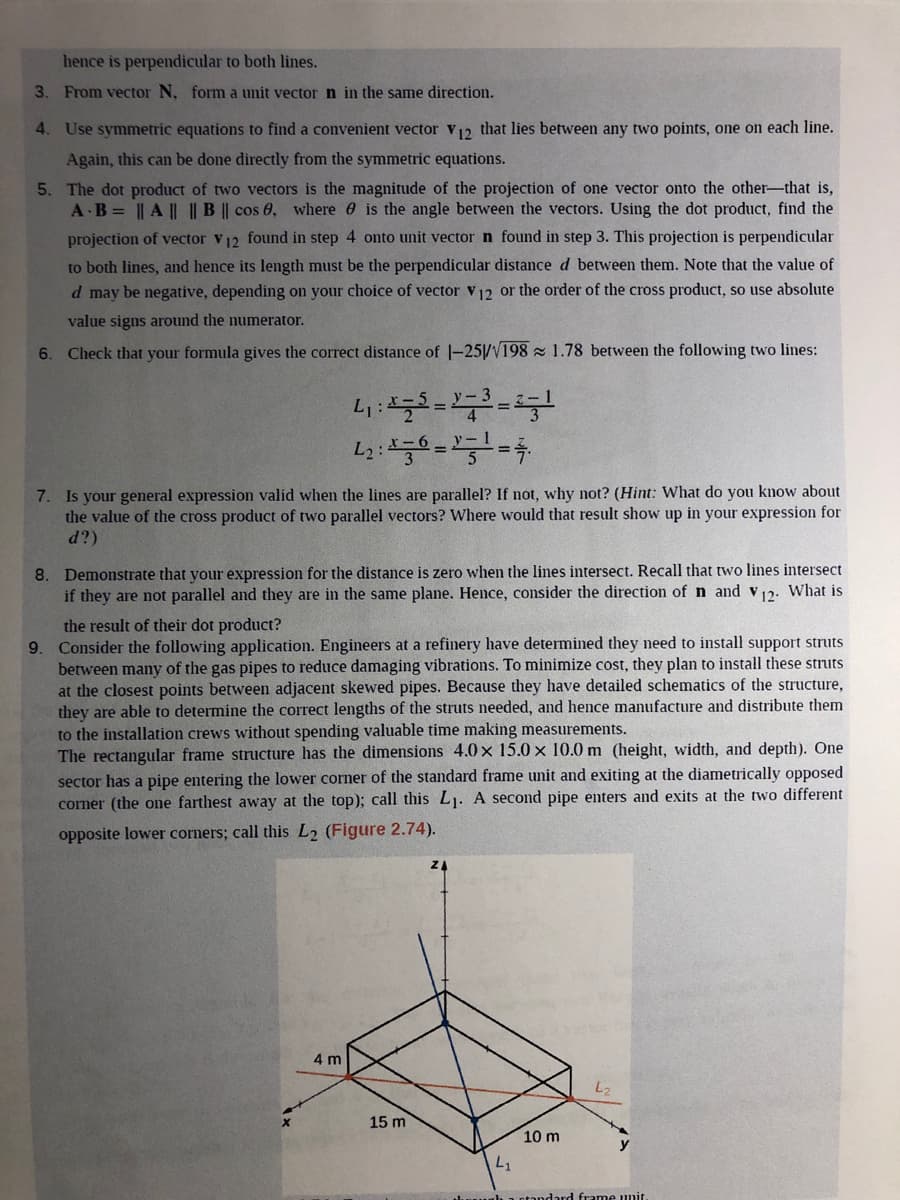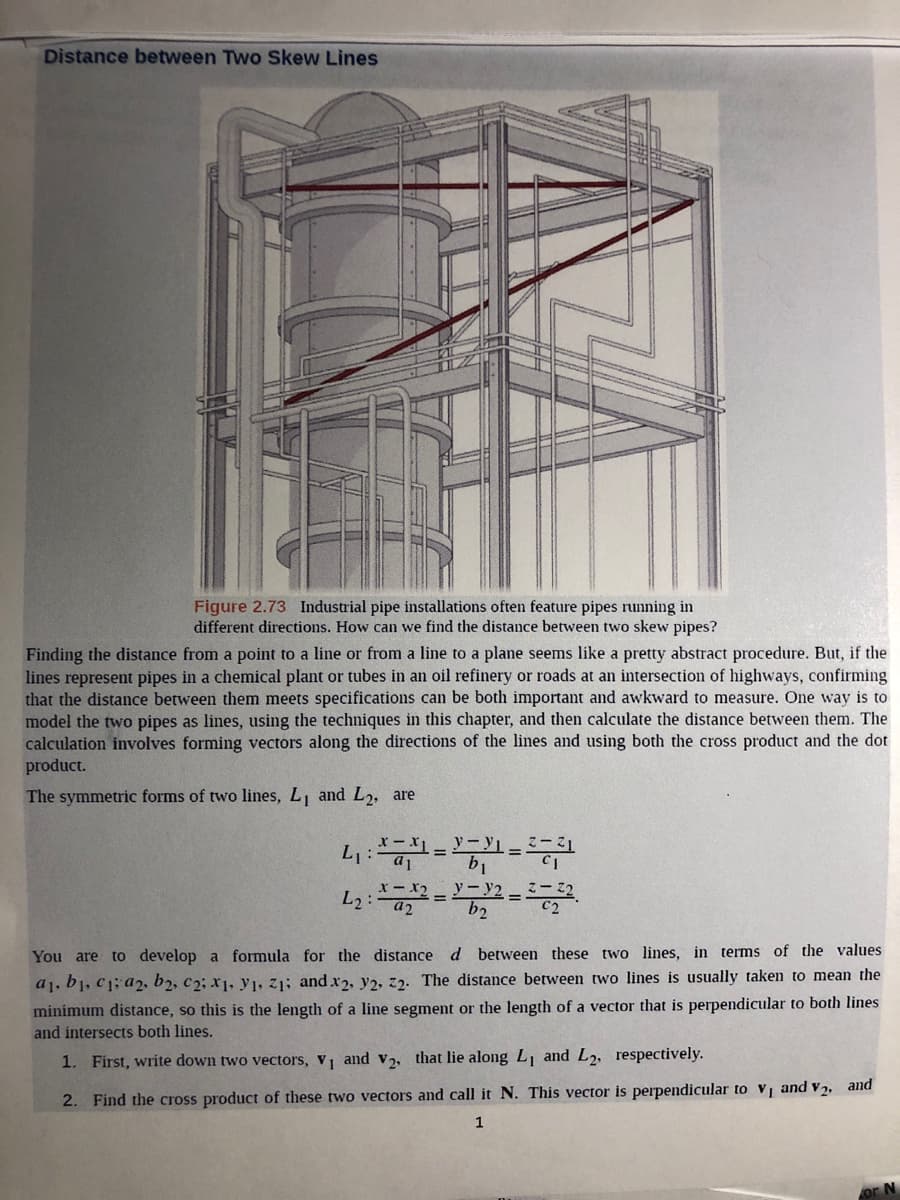Algebra & Trigonometry with Analytic Geometry
13th Edition
ISBN:9781133382119
Author:Swokowski
Publisher:Swokowski
Chapter3: Functions And Graphs
Section3.3: Lines
Problem 74E
Related questions
Topic Video
Question
100%
Please help with #6 through #9. Thank you

Transcribed Image Text:hence is perpendicular to both lines.
3. From vector N, form a unit vector n in the same direction.
4. Use symmetric equations to find a convenient vector v12 that lies between any two points, one on each line.
Again, this can be done directly from the symmetric equations.
5. The dot product of two vectors is the magnitude of the projection of one vector onto the other-that is,
A B = || A || || B || cos 0, where is the angle between the vectors. Using the dot product, find the
projection of vector v12 found in step 4 onto unit vector n found in step 3. This projection is perpendicular
to both lines, and hence its length must be the perpendicular distance d between them. Note that the value of
d may be negative, depending on your choice of vector v12 or the order of the cross product, so use absolute
value signs around the numerator.
6. Check that your formula gives the correct distance of |-25/V198 1.78 between the following two lines:
7. Is your general expression valid when the lines are parallel? If not, why not? (Hint: What do you know about
the value of the cross product of two parallel vectors? Where would that result show up in your expression for
d?)
8. Demonstrate that your expression for the distance is zero when the lines intersect. Recall that two lines intersect
if they are not parallel and they are in the same plane. Hence, consider the direction of n and v12. What is
the result of their dot product?
Consider the following application. Engineers at a refinery have determined they need to install support struts
between many of the gas pipes to reduce damaging vibrations. To minimize cost, they plan to install these struts
at the closest points between adjacent skewed pipes. Because they have detailed schematics of the structure,
they are able to determine the correct lengths of the struts needed, and hence manufacture and distribute them
to the installation crews without spending valuable time making measurements.
The rectangular frame structure has the dimensions 4.0 x 15.0 x 10.0 m (height, width, and depth). One
sector has a pipe entering the lower corner of the standard frame unit and exiting at the diametrically opposed
cormer (the one farthest away at the top); call this L1. A second pipe enters and exits at the two different
9.
opposite lower corners; call this L2 (Figure 2.74).
4 m
15 m
10 m
a standard frame unit.

Transcribed Image Text:Distance between Two Skew Lines
Figure 2.73 Industrial pipe installations often feature pipes running in
different directions. How can we find the distance between two skew pipes?
Finding the distance from a point to a line or from a line to a plane seems like a pretty abstract procedure. But, if the
lines represent pipes in a chemical plant or tubes in an oil refinery or roads at an intersection of highways, confirming
that the distance between them meets specifications can be both important and awkward to measure. One way is to
model the two pipes as lines, using the techniques in this chapter, and then calculate the distance between them. The
calculation involves forming vectors along the directions of the lines and using both the cross product and the dot
product.
The symmetric forms of two lines, L, and L2, are
L :
b1
y-y2
b2
You are to develop a formula for the distance d between these two lines, in terms of the values
a1, b1, C1;a2, b2, c2; x1, y1, z1; and r2, y2, 22. The distance between two lines is usually taken to mean the
minimum distance, so this is the length of a line segment or the length of a vector that is perpendicular to both lines
and intersects both lines.
1. First, write down two vectors, v and v, that lie along L, and L2, respectively.
2. Find the cross product of these two vectors and call it N. This vector is perpendicular to V and v2, and
1
Expert Solution
This question has been solved!
Explore an expertly crafted, step-by-step solution for a thorough understanding of key concepts.
This is a popular solution!
Trending now
This is a popular solution!
Step by step
Solved in 2 steps with 1 images

Knowledge Booster
Learn more about
Need a deep-dive on the concept behind this application? Look no further. Learn more about this topic, calculus and related others by exploring similar questions and additional content below.Recommended textbooks for you

Algebra & Trigonometry with Analytic Geometry
Algebra
ISBN:
9781133382119
Author:
Swokowski
Publisher:
Cengage

Algebra & Trigonometry with Analytic Geometry
Algebra
ISBN:
9781133382119
Author:
Swokowski
Publisher:
Cengage